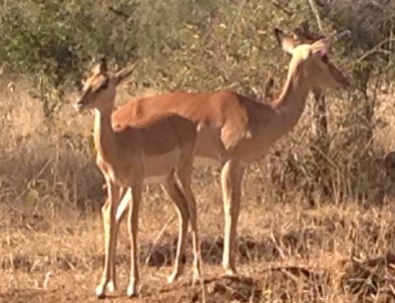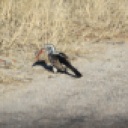One sunny day, we went to look for lions in Kruger National Park in South Africa. We spotted zebras, giraffes, a leopard, a rhinoceros, elephants, hippopotamuses, baboons, impalas, kudus, a variety of birds and more fawns and monkeys and even, warthogs and crocodiles…but not the elusive king of beasts.
We heard four lions had escaped from Kruger during our sojourn. But did we meet any of them?
I think I heard them at midnight as I woke up to the sounds of roars in my hotel room at Kruger gate.
My elder son and our guide heard them too around six in the morning when they were queuing up for tickets to enter Kruger. We had to buy a permit every time we went into Kruger. As lions are supposed to be more likely to be visible in the small hours of the morning, we decided to enter as soon as the gates opened at 6.30 am. The rangers had said the lions were at the bridge in the hedges.

On our last day, we saw three lionesses basking in the sun on a sand bank mid-morning. We were so excited that we got off the car and stood on the bridge watching them! Getting out of the vehicle is not something one does in Kruger for one could frighten the animals or become a prey to them incase they are hungry and starved, though they are supposed to be rather averse to human meat.

Though we did not see predators chase preys, we did see impalas and wildebeests chase each other in play and we did get chased by angry elephants a couple of times.
Animals by and large liked to cross roads that were made for men to drive on in Kruger. We saw zebras crossing, impalas crossing, monkeys crossing, kudus crossing, wildebeests crossings rhino crossing… and, we thought, therefore, as a matter of course elephants crossing…
The first time the elephant that was headed for the road got angered when my thirteen-year-old shouted for excitement on seeing a bull come towards the road and the car. Our windows were open. His voice carried and the elephant headed for us and our guide started the car and headed for the far distant reaches…

The elephant crossed the road and passing cars heaved a sigh of relief and congratulated us on our lucky escape!
Why this sole elephant decided to cross the road where we had parked is an issue on which we still need to ponder and wonder…
One of the best ways for spotting animals in Kruger is to stop where there is a crowd of cars. That is how we spotted our lions, the elephant herds, giraffes and zebras…and a number of other sightings. And our car started the crowding for the leopard that my husband had found stalking the impalas. Other cars followed to watch the drama. In Kruger, humans stay in car cages and view the animals that roam freely. Sometimes, the animals walk right by your car. Occasionally, they walk with your car. Birds hop by. Once a flock Guinea fowls crossing the road held up traffic! Sometimes, it is monkeys…I recall how vehicles containing humans drew to a halt when some baby monkeys decided to play a game of hopscotch in the middle of the road!

Though we spent two-and-a-half days looking for lions in Kruger, we saw very less of the park as it stretches over an area that could contain more than 27 Singapores, and beyond to Mozambique, Zimbabwe and the Limpopo river. We only saw the part around Sabi River and drove out ultimately through the South Gate, close to Nelspruit. The land rolled out for miles beckoning animal lovers. It was relaxing and entertaining to watch crocodiles with their mouth open, waiting for their dinner at the water holes, hippopotamuses stroll into a stream and giraffes munch leaves in the afternoon sun. We even caught two young hippos play and splash water at each other.
A variety of eagles, vultures and birds dotted the landscape. At lunch, we were surprised by a Cape glossy starling waiting for crumbs. At dinner, outside Kruger gate, we had a night visitor from the park, a bush baby. It created a stir among the tourists. It did a round of the Lapa barbecue area and we were all taking pictures of it. Cute would be the right word for this exhibitionist! The next day, we had a picnic breakfast at a hilltop in Kruger and had a yellow-billed hornbill visit us. It even posed for our cameras…
There are many lakes, waterholes and hills. The part that edges Mozambique is very scenic. We saw the Orpen Dam with its lush vegetation, the South African blue crane, Egyptian geese, hippos and crocodiles. We watched the animal and bird life through binoculars as they were unreachable and far…
But we had still not seen a lion. The land with its unique vegetation and animal life concealed the king from us.
I was also wondering if humans had ever inhabited this vast landscape or had it always been home of only animals? There were no clear answers till I googled …The land had earlier belonged to the Tsonga people, who were evicted by Paul Kruger, the president of the Transvaal Republic between 1883 and 1900 and other nature park lovers. The first cars drove into Kruger in 1926. Paul Kruger played a heroic role in the Boer wars and left the country when the Boers faced defeat in the hands of the British in the 1900s. He died in 1904 and was brought back to South Africa to be given a hero’s funeral and buried in Pretoria.
I wonder what happened to the Tsonga people…Perhaps the lions that evaded us through our entire sojourn in Kruger could tell us…
Maybe the lions in Kruger National Park avoided us because we had seen a lion behind a caging of electric wires in the Lion Safari in Johannesburg. That time, we had got off the car on the way to the Cradle of Humankind and the lion was fenced…We did not explore the park as we wanted to experience the wilds in Kruger…instead we went to see the goldmines and were taken around by a Tsonga guide. She told us that her name meant ‘to give’ in Tsonga!














The lions that escaped Kruger all met a sad end 😦 Great pics and story though – at least you were able to see a lioness
Thank you. Yes, it was sad that three out of the four were shot!
Lucky girl – such a wonderful happening trip to the wild. Thanks for sharing 🙂